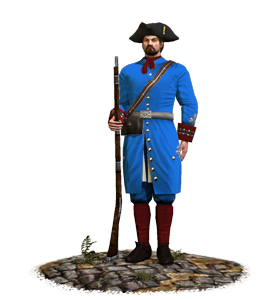Difference between revisions of "Blue Guard (ETW Unit)"
(Created page with "{{TW Unit|image=Image:Blueguard.png |Class=Elite Infantry |Unit Size=160 |Weaponry=Muskets |Region=The Netherlands |Recruitment Cost=1790 |Upkeep Cost=440 |Building Re...") |
Tango12345 (talk | contribs) m (Removed category "Empire Total War Units"; Quick-adding category "ETW Units" (using HotCat)) |
||
| (One intermediate revision by one other user not shown) | |||
| Line 17: | Line 17: | ||
Historically, the Blue Guards began as the personal bodyguard to Protestant William of Orange (later William III of England and Scotland). They followed him as he drove out the Catholic King James II after the “Glorious Revolution” of 1688. They were at the forefront of the attack during the Battle of the Boyne in Ireland in 1690, wading across the river to fall upon James’ line. With William’s claim to the throne secure after James’ defeat, the Blue Guards remained his personal bodyguards until his death in 1702: William could not bring himself to really trust Englishmen. After his death the Blue Guards returned to the Netherlands, and resumed duties there, playing a key role in the War of Spanish Succession. | Historically, the Blue Guards began as the personal bodyguard to Protestant William of Orange (later William III of England and Scotland). They followed him as he drove out the Catholic King James II after the “Glorious Revolution” of 1688. They were at the forefront of the attack during the Battle of the Boyne in Ireland in 1690, wading across the river to fall upon James’ line. With William’s claim to the throne secure after James’ defeat, the Blue Guards remained his personal bodyguards until his death in 1702: William could not bring himself to really trust Englishmen. After his death the Blue Guards returned to the Netherlands, and resumed duties there, playing a key role in the War of Spanish Succession. | ||
| + | |||
| + | |||
| + | == Details == | ||
| + | The Blue Guard are an elite unit, and should be treated as such. They can support the other infantry well if they are pread out between the regular line infantry, using their abilities and power to take the pressure off of other infantry. | ||
| + | |||
| Line 22: | Line 27: | ||
*[[Image:Dutch_flag.jpg|25px]] [[United Provinces (ETW Faction)|United Provinces]] | *[[Image:Dutch_flag.jpg|25px]] [[United Provinces (ETW Faction)|United Provinces]] | ||
| − | |||
[[Category:ETW Infantry]] | [[Category:ETW Infantry]] | ||
| + | [[Category:ETW Units]] | ||
Latest revision as of 10:01, 30 May 2017
 The Blue Guards are the elite bodyguard unit that serves the rulers of the Netherlands.
The Blue Guards are the elite bodyguard unit that serves the rulers of the Netherlands.
Description
All royal guards think of themselves as the elite of their national armies. Sometimes, they are court regiments where a martial appearance is valued more than real soldiering. The Blue Guards, however, have a tradition of fighting, and can shame any line regiment with their discipline and skill. This does not make them popular as they are, of course, all gentlemen and superior to any mere common infantry.
Historically, the Blue Guards began as the personal bodyguard to Protestant William of Orange (later William III of England and Scotland). They followed him as he drove out the Catholic King James II after the “Glorious Revolution” of 1688. They were at the forefront of the attack during the Battle of the Boyne in Ireland in 1690, wading across the river to fall upon James’ line. With William’s claim to the throne secure after James’ defeat, the Blue Guards remained his personal bodyguards until his death in 1702: William could not bring himself to really trust Englishmen. After his death the Blue Guards returned to the Netherlands, and resumed duties there, playing a key role in the War of Spanish Succession.
Details
The Blue Guard are an elite unit, and should be treated as such. They can support the other infantry well if they are pread out between the regular line infantry, using their abilities and power to take the pressure off of other infantry.
